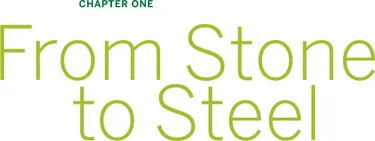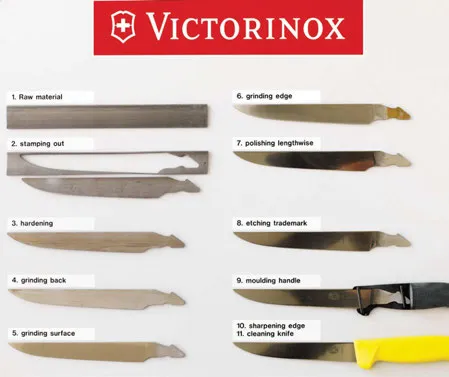![]()
![]()
Imagine the consternation our distant ancestors must have experienced after the first mastodon was felled. Now what? Eighteenth-century Scottish biographer and diarist James Boswell characterized our species as a “cooking animal.” But our ancestors’ use of fire is believed to be only half as old as their use of cutting implements.
Sharpened stones would do the job at first. The discovery of metals and alloys would further refine this most basic survival tool, essential for hunting, fabricating (cutting into parts), eating, and even protection. The progression from primitive tool to modern kitchen knife in effect illustrates the history of metallurgy and modern engineering.
THE STONE AGE
It is estimated that mankind began making stone tools about two and a half million years ago. The earliest cutting tools were fashioned from flint (a form of silica), obsidian (a volcanic glass similar to granite), quartzite, or even jade, all fairly homogeneous materials that yield rather sharp edges if properly fashioned. These stones were, however, brittle and suitable only for short implements, usually no longer than 4 or 5 inches long. The essential commodities of hides and meat could be cut with stone tools, but it’s unclear how durable the tools were.
Hard stones were used like a hammer to flake away bits of flint to achieve a point and sharp edges. No lathes, foundries, or fancy factories were required—the work space was simply a large rock or tree stump. Handles were fashioned from wood or bone, using a similar method. A short handle attached to a blade became a knife, a longer one indicated an axe, even longer, a spear. The shapes of many of our modern cutting tools bear an uncanny likeness to their Stone Age counterparts.
THE BRONZE AGE
The Bronze Age is not any one particular period but rather a stage of metallurgical advancement that occurred at different times in different parts of the world. The early Bronze Age is sometimes referred to as the Copper Age. Raw copper was pounded into tools as early as 10,000 B.C., but it proved too soft to make durable cutting tools. Bronze, an alloy made up of 85 to 95 percent copper most commonly mixed with tin, is harder than pure copper and melts at a lower temperature. Hard tools and weapons fashioned from bronze retained an edge far better than stone. So while very few implements of pure copper have been found, bronze knives have been discovered in great abundance in archeological digs all over Europe. Bronze artifacts, including knives, dating back to about 3000 B.C. have been found in the Near East, and recent discoveries indicate a Bronze Age in Thailand as far back as 4500 B.C.
THE IRON AGE
The history of the modern knife begins not with the discovery of iron, but with the ability to smelt it and control its properties. That our modern knives are made from iron (to which carbon has been added to make steel) is a testament to our ancestors’ ability to solve problems by trial and error—lots of error. Iron is much more difficult to smelt than copper. It requires a higher temperature and is actually still hard at the temperature at which copper melts. Iron contains impurities called slag. Some smith, perhaps out of extreme frustration, discovered that by hitting a lump of near-molten iron he was able to extract the slag. The resulting pure iron, known as wrought iron, is a soft iron that is carbon-free.
Introduce carbon into iron and the result is steel. The carbon came from the charcoal-fired forges in which the smelting was done—as a smith hammered away at the sword or plowshare he was unwittingly carburizing the iron and making steel. Hammering long enough (forging) to get the carbon content up to 1 percent produced a far stronger tool, one that could hold an edge better than one made of bronze. There is no written record of this process. Each batch of iron was different and a talented smith came to recognize which ores yielded the best results. The use of flux, an ingredient added to the iron-charcoal mix, reduced the temperature at which the slag melted, thereby making smelting easier.
THE INDUSTRIAL AGE AND BEYOND
Once iron and steel-making were understood, the focus shifted to making knives of greater weight, thus increasing their ability to cut with less effort. It became cheaper to produce knives and they became more readily available. Several cities in Europe became major centers for knife manufacturing: Sheffield, England; Thiers, France; and Solingen, Germany. In the United States there were knife manufacturers in Connecticut and Massachusetts, most founded in the early nineteenth century. All of these early manufacturing centers had three things in common: a nearby supply of iron ore, fast-flowing rivers or streams to run waterwheels, and an abundance of wood from which to make charcoal to fire the furnaces.
Prior to 1921, most kitchen knives were made from an alloy known as carbon steel, a combination of iron and carbon with few other trace elements. Many knife aficionados prefer carbon steel because it can take a keen edge. While the edge dulls rather quickly, it can be quickly steeled back into shape. Carbon steel’s big drawback is that it will discolor almost immediately when it comes in contact with acidic foods and will discolor over time just from exposure to air. It will also rust if left damp, and letting a carbon steel knife go to rust will seriously impair its cutting edge. Carbon steel knives require diligent maintenance to keep them looking good and working well, and the average consumer usually doesn’t want to bother with what is considered a high-maintenance knife.
During the 1920s, knife manufacturers began using stainless steel, which produced a blade that stayed sharper longer than the carbon steel blade. However, stainless steel is too hard to be sharpened on a steel. Its hardness is too close to that of a steel for the latter to have any effect.
The high-carbon stainless steel knives that most of us use today were developed after World War II and, in my opinion, prove to be the perfect compromise. If you look at the logo side of some high-carbon stainless knives, you will see the formula X 50 Cr MoV 15. The alloy used to make high-carbon stainless contains .5 percent carbon—the ingredient essential for turning iron into steel. The amount of chromium, molybdenum, and vanadium totals 15 percent, at least 13 percent of which must be chromium. This carefully balanced metallurgical cocktail prevents the oxidation that defaces the carbon steel knife and increases the strength and flexibility of the blade. All this science results in knives that are corrosion-resistant, that will maintain an edge for a reasonably long time, and that can be refreshed with a few strokes of the steel.
Below are two carbon steel chef’s knives—one new, one old. The top one is a French-style knife made by Sabatier, one of the few manufacturers that still makes them. The bottom knife is made by Dexter-Russell. I purchased this knife in the late 1960s. Note the discoloration despite the fact that it was given periodic scrubbing with scouring powder and a moistened Champagne cork. It is still sharp but if you look carefully, you will notice the original curve of the blade has been destroyed (by a street grinder who did not sharpen the edge properly).
MODERN KNIFE MAKING
There are three methods of knife making used today: drop-forging, precision forging, and stamping.
In August 2006, I had the opportunity to take a trip to Solingen and Deizisau, Germany, to visit the Wüsthof, Henckels, and F. Dick factories, as well as that of Julius Kirschner and Sons, the last remaining drop-forge in Solingen. Drop-forging, an old style of knife making, is a loud, messy, sidewalk-cracking process that produces fine knives but is not especially friendly to the surrounding environment. I gained a great appreciation for how knives (and steels at F. Dick) were made.
The photo above shows various stages in the drop-forging process. From bottom to top they are: the cut blank, pressing after drop-forging, removing the flashing, the raw knife outline before tapering, the tapered and polished knife, and the finished product. The pieces in this photo were given to me by Wüsthof many years ago to show my students so that they could see firsthand the intricacies of knife making.
First a thick plank of alloyed steel is die-cut, heated, then placed in the drop-forge to produce a flat piece. The flashing is cut away and the knife blank is ready to begin the heat treatment process, during which the subsequent tempering (heating followed by quick cooling to harden the steel) and annealing (heating followed by slow cooling to prevent brittleness) temperatures are carefully controlled. The quick-cooling process known as quenching, usually in a vat of oil, is probably the most critical phase, in which the heated metal undergoes a quick and drastic drop in temperature.
The knife comes out of the heat treatment process looking pretty awful. It is still thick, so it must be taper-ground and then highly polished, which helps prevent corrosion. The handles are attached and polished, then the beveled edge is ground on. Finally the knife is given its last human and machine inspections.
Precision forging is quite different from the drop-forging method. The cut blank is heated in the center only to form the bolster and then is subjected to the same heat treatment, taper-grinding, polishing, handle attachment, and beveling processes as in drop-forging. Instead of die-cutting a blank from a thick steel plank, the blank is cut from rolls of steel.
The photo above illustrates the process used to make a stamped knife, in this case a boning knife. Not all knives have a full tang or bolster—those are just the top-of-the-line versions that knife manufacturers make. As you can see from the photo, after the flashing has been cut away (second from top left), this boning knife has neither, yet it is made by a company with a reputation for quality, even in their stamped line, and this is true for many manufacturers. The forged knife will usually have an advantage in overall quality but for some tasks, such as boning and filleting, a stamped knife will suffice.
Despite all...





